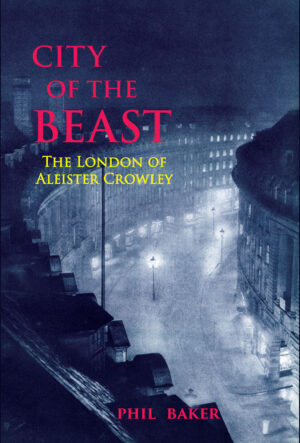Book review: City of the Beast
As a subject for occult biography, Aleister Crowley seems to get the lion’s – or perhaps the beast’s would be a better term – share of attention. Phil Baker’s new biographical study, City of the Beast: The London of Aleister Crowley (Strange Attractor, 2022) is something special though. Described as a ‘biography by sites’, City of the Beast explores Crowley’s life via his relationship with the city of London, a place where he spent much of his adult life.
The book is divided into 93 locations, beginning with the tomb of Sir Richard Burton in Mortlake, and ending with 93 Jermyn Street – Crowley’s last residence in London. This seems, at first glance, to be a strange approach to biography, yet it unquestionably works, and London itself is revealed as a character through Baker’s meticulous research of Crowley’s life from the late Victorian to the horrors of the Blitz and beyond. Drawing heavily on Crowley’s unpublished diaries and other archival sources, Baker invites us to enter the London of the Great Beast’s life; a city sometimes tantalizing, at others, tawdry. It is a London of clubs, restaurants, bookshops, and dubious dens. A London where Crowley’s social circuit includes the famous and the feted – such as Dennis Wheatley, Thomas Driberg, and Dion Fortune. But even more of interest is the Londoners who don’t usually get attention from biographers, such as the many prostitutes whose services Crowley engaged in Soho and Pimlico. Crowley seems to have meticulously recorded these encounters in his diaries, yet as Baker shows, he frequently disguised their nature so as not to tip off whichever woman he was currently living with.
Readers who wish to retain a romantic view of Crowley will be disappointed, perhaps even appalled. Here are Crowley’s failed court cases, his tempestuous relationships with the various ‘scarlet women’; his constant quest for disciples with money, influence, or both. His casual cruelties to lovers, friends, and followers. As Baker points out, Crowley knowingly portrayed himself as “a reactionary Tory of the most bigoted type” – a man who felt it necessary to maintain the airs and graces of a gentleman – even whilst dodging his creditors.
With an introduction by Timothy d’Arch Smith, an afterword focusing exclusively on Crowley’s London of the 1890s; extensive notes, and bibliography; City of the Beast is an outstanding addition to the ever-growing biographical corpus which is the legacy of Aleister Crowley. Immensely readable, witty, and at times rather sad, but if you are at all interested in Crowley’s madcap career – simply a must-read!

